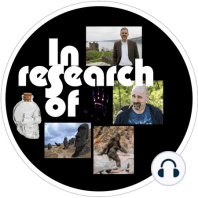2 min listen
S01E17 - The Easter Island Massacre
FromIn Research Of
ratings:
Length:
89 minutes
Released:
Feb 10, 2020
Format:
Podcast episode
Description
Watch the ISO episode on YouTube. Jeb and Blake are joined by Dr. Carl P. Lipo to talk about "The Easter Island Massacre" episode of In Search Of. Our guest, Dr. Carl P. Lipo, is the author (along with Terry Hunt) of The Statues that Walked and conducted research that demonstrated a very plausible method for how the statues of Rapa Nui (Easter Island) were moved from their stone quarry. (See some of the history around testing various methods at this link.) NatGeo video of The Statues that Walk presentation with Lipo and Hunt. Jump to the "good stuff" and see a Moai walk NOVA special on Easter Island (via Amazon Prime) Dr. Edmundo Edwards is profiled in the episode. Nimoy seems to be wearing a very similar outfit to the Dracula episode, and we'll be looking back at this data in our Season 1 wrap-up feature in a few weeks. And - achievement unlocked - we've hit another image from the show's title sequence. Curiously, of the images in the title sequence (Earhart, a Galaxy, Moai, Castle Urqhart, Druids, and Crystal Skulls) I think only the Crystal Skulls fail to get their own coverage this season. I need to double-check that, but I think we cover the galaxy in the SETI episode, we'll get to Nessie and Druids too, and we've already covered Earhart. So... we'll see what's up (if anything) with the crystal skulls. Some of the Moai are truly massive - but calling people "flyspecks" by comparison is a bit of a poetic stretch. There are some really great photos at the Thor Heyerdahl page on the Kon-Tiki website. The sheer mass of these things is quite stunning. Expand your vocabulary! The orographic effect is a change in atmospheric conditions caused by a change in elevation, primarily due to mountains. What are the Moai? (from Wikipedia) Moai are monolithic human figures carved by the Rapa Nui people on Easter Island in eastern Polynesia between the years 1250 and 1500. Nearly half are still at Rano Raraku, the main moai quarry, but hundreds were transported from there and set on stone platforms called ahu around the island's perimeter. Almost all moai have overly large heads three-eighths the size of the whole statue. The moai are chiefly the living faces (aringa ora) of deified ancestors (aringa ora ata tepuna). The statues still gazed inland across their clan lands when Europeans first visited the island in 1722, but all of them had fallen by the latter part of the 19th century. Pukao - the "hats" on the top of some Moai Rongorongo - the still undeciphered language remnants found in the Pacific islands. Counting coup was mentioned - this is explained here but it was a way to demonstrate bravery by daring feats. Tiki Sidebar: Don's Beachcomber (the original chain) is gone (closed 1985) and as of 2018, the sites that had taken up the torch of keeping the brand alive were struggling. Donn Beach obituary Trader Vic's Vic Bergeron obituary 1947 coverage of Kontiki Expedition Check out http://TikiRoom.com for some fascinating photos and memorabilia from peak Tiki. Begs The Question: A couple of times in the episode the phrase "begs the question" is used. Since this is a show that caters to some degree of pedantry, it's worth mentioning that we are aware that the fallacy of "begging the question" is not the same as the colloquial usage which means "raise the question." Raising a question has little to do with rhetorical usage. However, leaning into the prescriptive interpretation of the phrase must be done by disregarding the vast popular tendency to use the phrase to mean "raise the question." "Begging the question" rhetorically is a kind of circular argument wherein one's premise is unsupported within the argument save through conversational assertions. You can read all about it over at Merriam Webster. One can be adamant about the proper usage of the phrase but would do so at the risk of being obliterated by the power of the general public to mutate the meaning of words and phrases. It would be awfully egregious to igno
Released:
Feb 10, 2020
Format:
Podcast episode
Titles in the series (96)
Quick Update - End of Season 1: Hey folks, we hope you enjoyed season 1 of In ReSearch Of. We've got a special oversized season wrap-up episode coming but I'm going to have to push it out a week. I just need a breather. Lots of stuff going on - but hey, the whole world's... by In Research Of
